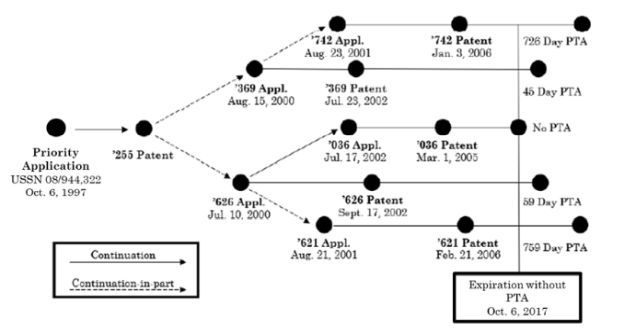The judicial-made doctrine of obviousness-type double patenting (ODP) is intended to prevent patent system gamesmanship such that applicants cannot obtain an unjustified extension of patent term beyond the statutory 20 years from the earliest priority filing date of the underlying application. If the claims of a later-expiring patent would be obvious variants of those of an earlier-expiring patent in which there is a common inventive entity, common ownership, a common inventor and/or a common assignee or owner between the two documents, the claims of the later-expiring patent are unpatentable and invalid under ODP. Thus, in a patent family that includes one or more continuation or continuation-in-part applications, calculation of expiration dates is crucial in determining potential unpatentability under ODP.
Patent Term Adjustment (PTA) and Patent Term Extension (PTE) can be granted to an issued patent to extend the life of the patent beyond the statutory term of 20 years from the earliest filing date. PTA is granted to compensate the applicant for patent term loss due to administrative delays incurred during prosecution before the United States Patent and Trademark Office (USPTO). See 35 U.S.C. § 154. PTE is awarded to compensate for delays incurred in obtaining regulatory approval on a patented product or methods of manufacturing or using the product. See 35 U.S.C. § 156.
Although PTA and PTE both serve to extend the life of a patent beyond the statutory term, how PTA and PTE are to be analyzed and treated in an ODP analysis has not been clear. The United States Court of Appeals for the Federal Circuit in In re Cellect, Nos. 2022-1293, 2022-1294, 2022-1295, 2022-1296, 2023 WL 5519716 (Fed. Cir. Aug. 28, 2023), recently weighed in on the application of granted PTA and PTE in an ODP analysis as well as the relationship between ODP and the grant of PTA.
Case Background
Cellect LLC owns U.S. Patent Nos. 6,982,742 ('742 patent), 6,424,369 ('369 patent), 6,452,626 ('626 patent) and 7,002,621 ('621 patent). This patent family also includes U.S. Patent No. 6,862,036 ('036 patent), a continuation-in-part of the '626 patent. Each family member claims priority to a priority application, U.S. Application Serial No. 08/944,322, filed October 6, 1997, as shown in the below diagram reproduced from the Federal Circuit's opinion, which has been edited to include priority application data and provide the correct expiration date without PTA:

As shown in the above figure, any patent issuing from the priority application expires October 6, 2017, excluding PTA or PTE. The USPTO granted each of the '742, '369, '626 and '621 patents PTA whereas the '036 patent did not receive any PTA. No terminal disclaimers were filed during prosecution of any of the patents in the family.
Cellect sued Samsung Electronics Co. alleging infringement of the '742, '369, '626 and '621 patents. Samsung requested ex parte reexamination of the asserted patents, alleging unpatentability on the grounds of ODP. During reexamination, the examiner finally rejected the asserted claims of each of the asserted patents as unpatentable under ODP. The grounds for unpatentability in each of the asserted patents could be traced to the '036 patent, which did not receive any grant of PTA. The relationship between the claims of each asserted patent against Samsung in the reexamination proceeding is illustrated below:

In short, the asserted claims of the '621 patent were found to be unpatentable over the claims of the '626 patent, whose asserted claims along with those of the '742 patent were found to be unpatentable over the claims of the '369 patent, whose asserted claims were found to be unpatentable over the claims of the '036 patent.
Cellect appealed the rejections to the Patent and Trial Appeal Board, relying on the Federal Circuit's decision in Novartis AG v. Ezra Ventures LLC, 909 F.3d 1367 (Fed. Cir. 2018), holding that ODP cannot invalidate a statutory grant of PTE, and arguing that, similarly, ODP cannot be used to invalidate a statutory grant of PTA.1
The Board affirmed the examiner's rejections from the reexamination proceedings, holding that the expiration dates in an ODP analysis should be calculated after the addition of PTA and distinguishing from the application of PTE in ODP. In its analysis of the application of PTE in ODP, the Board relied on the holdings of Merck & Co. v. Hi-Tech Pharmacal Co., 482 F.3d 1317 (Fed. Cir. 2007), and Novartis. In Merck, the Federal Circuit held that the filing of a terminal disclaimer to obviate ODP does not invalidate a statutory grant of PTE. See Merck at 1322. Thus, PTE is added and considered after application of the terminal disclaimer, and the resulting expiration date in an ODP analysis is the disclaimed expiration date and not the expiration date in the absence of a terminal disclaimer. See id. at 1322-23. Novartis did not involve the filing of a terminal disclaimer prior to the grant of PTE and, in following Merck, the calculation of the expiration date is determined from the original expiration date prior to the addition of PTE. See Novartis, 909 F.3d at 1373-74. With respect to the application of PTA in ODP, the Board relied on the statutory language of 35 U.S.C. § 154(b)(2)(B) in which terminal disclaimers are applied after the grant of PTA such that PTA cannot extend the patent term beyond the expiration date of the terminally disclaimed patent, and the role of terminal disclaimers in addressing ODP to prevent applicants from obtaining a later-expiring patent on an invention covered by the earlier patent such that the two patents would have different terms due to PTA. The Board held that the adjusted expiration date that includes the granted PTA should be used to calculate expiration dates in an ODP analysis and the application of any terminal disclaimer occurs after determination of the adjusted expiration date.
Cellect appealed the Board's decision to the Federal Circuit.
The Federal Circuit's Decision
On appeal, Cellect argued that under Novartis, a judicial-made doctrine (i.e., ODP) cannot cut off a statutory grant of an extension of patent term, and because PTA and PTE are both authorized under statute, ODP cannot be used to terminate PTA. Based on this similar treatment of PTA and PTE, the calculation of patent expiration date in an ODP analysis should be the original expiration date prior to the addition of granted PTA or PTE. Cellect also argued that the PTA and PTE statutes utilize the obligatory language "shall" with respect to the extension of the patent term upon the satisfaction of the requisite conditions. See 35 U.S.C. §§ 154(b)(1)(A), (b)(1)(B), (b)(1)(C), 156(a).
The USPTO argued that the differences in statutory language in the PTA and PTE statutes indicate that PTA and PTE should be treated differently in an ODP analysis. One notable difference is that the PTA statute, Section 154, mentions terminal disclaimers ? whereas in contrast, the PTE statute, Section 156, does not. Despite use of the obligatory language "shall" with respect to the extension of patent term, the PTA statute is clear that grant of PTA may be limited by the application of a terminal disclaimer in contrast to the absence of terminal disclaimers in the PTE statute. This difference between the statutes indicates the legislative intent to treat PTA and PTE differently.
The Federal Circuit affirmed the Board's decision, holding that in the analysis of whether claims are unpatentable based on ODP, the expiration date for a patent having PTE is determined from the original expiration date (including application of any terminal disclaimer) before the addition of PTE, whereas in the case of PTA, the expiration date for ODP analysis is calculated after the addition of any granted PTA (i.e., the adjusted expiration date) regardless of whether a terminal disclaimer has been filed.
The court first reasoned that similar treatment of PTE and PTA in ODP analysis based on their statutory grant of extension of patent term would be "an unjustified attempt to force disparate statutes into one" because the statutory frameworks for PTE and PTA are different and their application arises under different and distinct circumstances. Cellect, 2023 WL 5519716, at *7. The Federal Circuit also relied on Merck regarding the inability of ODP and the filing of a terminal disclaimer to cut off any granted PTE. Based on Merck and Novartis, the latter of which did not involve a terminal disclaimer, the court held that "ODP for a patent that has received PTE should be applied based on the expiration date (adjusted to a disclaimed date if a terminal disclaimer has been filed) before the PTE is added, so long as the extended patent is otherwise valid without the extension." Id. at *8. Merck and Novartis further cemented the difference between PTE and PTA based on the distinct language between Sections 154 and 156 regarding the separate and distinct requirements for obtaining the extension of patent term, the application of terminal disclaimers and their effect on PTA in the prevention of extending patent term beyond the date of the terminal disclaimer in the provisions of Section 154.
The court also noted that ODP must continue to apply when applications directed to two inventions having overlapping subject matter are simultaneously filed and the underlying issued patents have different expiration dates based on the differences in granted PTA. See AbbVie Inc. v. Mathilda & Terence Kennedy Inst. of Rheumatology Tr.,764 F.3d 1366, 1373-74 (Fed.Cir. 2014).
While the court took note that no terminal disclaimers were filed in the prosecution of the asserted patents, it indicated that terminal disclaimers are often filed to overcome a rejection under ODP and that "ODP and terminal disclaimers are two sides of the same coin: the problem and the solution" such that "the statutory recognition of the binding power of terminal disclaimers in § 154(b)(2)(B) is tantamount to a statutory acknowledgement that ODP concerns can arise when PTA results in a later-expiring claim that is patentably indistinct." Cellect, 2023 WL 5519716, at *9 (internal quotation omitted). The absence of a terminal disclaimer thus frustrates the intentions of Congress to prevent patents with PTA from having a patent term extending beyond the date of the terminal disclaimer.
Accordingly, based on the distinctions in their underlying statutory provisions and framework, the different circumstances under which PTE and PTA can be granted, precedent regarding the inability of ODP to cut off granted PTE, and Congress' intent to prevent extension of patent term beyond the date of a terminal disclaimer, the court held that PTE and PTA are treated separately in an ODP determination with respect to the calculation of expiration dates and that ODP can cut short a grant of PTA. The expiration date for ODP analysis of a patent granted PTE is based on the original expiration date, which includes the application of a terminal disclaimer and is established prior to the addition of PTE. In contrast, the expiration date for ODP analysis of a patent granted PTA, regardless of whether there is an applicable terminal disclaimer, is based on the adjusted expiration date?or, in other words, the expiration date after the addition of PTA.
Conclusion and Analysis
In holding that in consideration of ODP, the expiration date for a patent having PTE is calculated from the original expiration date or disclaimed date of the patent, the expiration date for a patent having PTA is calculated after the addition of granted PTA, and establishing that ODP can cut off granted PTA, the Federal Circuit's decision clarifies the distinction between the statutory frameworks and requirements for the grant and application of PTE and PTA.
However, the decision also weakens the effect of PTA in extending patent term to compensate diligent applicants for administrative delays at the USPTO during prosecution, especially in patent families having multiple family members. Often, issued patents within a family are directed to incremental breakthroughs based on an original disclosure. Each issued patent in a family is likely to have differing grants of PTA based on unpredictable delays, resulting in varying patent terms. Cementing that ODP is sufficient grounds to terminate a grant of PTA effectively ties the longest potential patent term amongst family members to that of the one having the earliest expiration date regardless of USPTO administrative delays experienced during prosecution of each family member and despite any applicant diligence in timely responding to USPTO communications and minimizing applicant delays absent a showing of patentable distinction between conflicting claims of family members, or if, for example, a family member is a divisional application filed as the result of a restriction requirement in a prior-filed application and subject to the safe harbor provision preventing citation of the issuing patent or filed application against the divisional application. Thus, the awarded PTA appearing on the face of an issued patent in a patent family with multiple members may be hardly an award for the diligent applicant and instead amount to merely a participation trophy.
In view of In re Cellect, practitioners may seek to revise patent procurement and prosecution strategy, assessing whether an ODP risk is present in a patent portfolio. The risk of ODP is present in continuation or continuation-in-part applications and practitioners should evaluate ahead of filing whether the pursued claims are patentably distinct. Another strategy may be to rely on divisional applications and the safe harbor provision, via the presentation of additional claims at filing directed to multiple aspects of the disclosed invention and prosecuting each aspect stepwise following a restriction. Pharmaceutical applicants may instead consider PTE ahead of regulatory review and approval on its key assets.
For More Information
If you have any questions about this Alert, please contact Thomas J. Kowalski, Deborah L. Lu, Ph.D., Brandon A. Chan, Ph.D., any of the attorneys in our Intellectual Property Practice Group or the attorney in the firm with whom you are regularly on contact.
Footnotes
1. To maintain focus of the discussion on the analysis of PTE and PTA in ODP, Cellect's remaining arguments are only briefly discussed.
Cellect further argued that a rejection based on ODP is improper under the equitable principles underlying ODP, namely preventing an unjustified extension of patent term and harassment from multiple assignees, and that the examiner in the original prosecution of the challenged patents had considered ODP such that the issuance of the ODP rejection during reexamination did not amount to a substantial new question of patentability.
The Board did not find these arguments persuasive, holding that there was an unjustified extension of patent term, the risk of harassment by multiple assignees remained active, and the ODP rejections raised during reexamination were proper because there was no indication during the original prosecution that the examiner ever considered ODP, rendering the substantial new ground of unpatentability proper.
Cellect reiterated these arguments on appeal to the Federal Circuit, which ultimately affirmed the Board's decision on similar reasoning. The Federal Circuit noted however that the nonasserted claims remain valid for the remainder of the patent term including granted PTA. See Cellect, 2023 WL 5519716, at *10.
Disclaimer: This Alert has been prepared and published for informational purposes only and is not offered, nor should be construed, as legal advice. For more information, please see the firm's full disclaimer.


